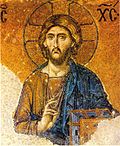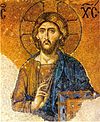- Greek Orthodox Church of Antioch
-
Greek Orthodox Patriarchate of Antioch and All the East 
Coat of armsFounder Apostle Peter Independence Apostolic Era Recognition Orthodox Primate Patriarch of Antioch and all the East Ignatius IV (Hazim) Headquarters Damascus, Syria Territory Syria, Lebanon, Iraq, Kuwait, UAE, Bahrain, Oman, parts of Turkey, (formerly Cyprus), United States, Canada, Mexico, Central America, South America, Australia, New Zealand, Oceania, Great Britain, Western Europe. Possessions Partial custody of the Church of the Holy Sepulchre Language Arabic, Greek, English, Spanish Adherents Estimated 2 million Website http://www.antiochpat.org/ The Greek Orthodox Church of Antioch, also known as the Greek Orthodox Patriarchate of Antioch and All the East and the Antiochian Orthodox Church (Greek: Πατριαρχεῖον Ἀντιοχείας, Patriarcheîon Antiocheías; Arabic: بطريركية أنطاكية وسائر المشرق للروم الأرثوذكس), is an autocephalous Greek Orthodox Church within the wider communion of Orthodox Christianity. Headed by the Greek Orthodox Patriarch of Antioch, it considers itself the successor to the Christian community founded in Antioch by the Apostle Peter.
It is one of several churches that lays claim to be the canonical incumbent of the ancient see of St. Peter and St. Paul in Antioch.The Oriental Orthodox Syriac Orthodox Church of Antioch makes the same claim, as do the Syrian Catholic Church, the Maronite Church, and the Melkite Greek Catholic Church, all of them Eastern Catholic Churches in full communion with the Holy See. These three, however, mutually recognize each other as holding authentic patriarchates, being part of the same Catholic communion. The Catholic Church also appointed titular Latin Rite patriarchs for many centuries, until the office was left vacant in 1953 and abolished in 1964 and all claims renounced.
The seat of the patriarchate was formerly Antioch, in what is now Turkey. However, in the 14th century, it was moved to the "Street called Straight" in Damascus, modern-day Syria, in response to the Ottoman invasion of Antioch. Its traditional territory includes Syria, Lebanon, Iran, Iraq, Kuwait and parts of Turkey. Its territory formerly included the Church of Cyprus until it became autocephalous in 431. Both the Orthodox Churches of Cyprus and Antioch are members of the Middle East Council of Churches.
Its North American branch is autonomous, although the Holy Synod of Antioch still appoints its head bishop, chosen from a list of three candidates nominated in the North American archdiocese. Its Australasia and Oceania branch is the largest in terms of area.
The head of the Orthodox Church of Antioch is called a Patriarch. The current Patriarch is Ignatius IV. Membership statistics are not available, but may be as high as 1,100,000 in Syria and 400,000 in Lebanon.
Contents
Administration and structure
Head of the Patriarchate of Antioch is Ignatius IV (Hazim) : Patriarch of the Great God-City of Antioch, Syria, Arabia, Cilicia, Iberia, Mesopotamia and All the East.
Metropolises and Metropolitans
in the Eastern Mediterranean:
- Metropolis of Damascus: Patriarchal diocese
- Metropolis of Beroea (Aleppo) and Alexandretta: Paul Yazigi (2000-present)
- Metropolis of Bosra, Hauran and Jabal al-Druze: Sawa Esber (1999-present)
- Metropolis of Emesa (Homs): George Abu Zaham (1999-present)
- Metropolis of Epiphania (Hama) and Exarchate of North Syria: Elias Saliba (1984-present)
- Metropolis of Laodicea and Exarchate of Theodorias: John Mansur (1979-present)
- Metropolis of Baghdad, Kuwait and All Mesopotamia: Constantinos Papastefanou (1969-present)
- Metropolis of Beirut and Exarchate of Phoenicia: Elias Audi (1980-present)
- Metropolis of Akkar: Basilios Nassur (2008-present)
- Metropolis of Mount Lebanon, Byblos and Botrys: George Khodr (1970-present)
- Metropolis of Seleucia and Heliopolis: Spyridon Khoury (1966-present)
- Metropolis of Tripoli and el-Koura: Ephraim Kyriakos (2009-present)
- Metropolis of Tyre and Sidon: Elias Kfoury (1995-present)
- Metropolis of Tarsos and Adana: vacanct
- Metropolis of Amida:(Diyarbakır) vacant
- Metropolis of Theodosioupolis(Erzurum): vacant
in Asia and Oceania:
- Antiochian Metropolis of Australia, New Zealand and the Philippines: Paul Saliba (1999-present)
in Europe:
- Antiochian Metropolis of Central and Western Europe: John Yazigi (2008-present)
in Latin America:
- Antiochian Metropolis of Buenos Aires and Argentina: Siluan Muci (2006-present)
- Antiochian Metropolis of Mexico, Venezuela, Central America and the Caribbean: Antonios Hedraui Tannus (1966-present)
- Antiochian Metropolis of Chile: Sergios Abad (1996-)
- Antiochian Metropolis of Brasil: Damaskinos Mansur (1997-)
Archdioceses and Archbishops
- Antiochian Orthodox Christian Archdiocese of North America (Englewood, New Jersey); Archbishop of New York and Metropolitan of All North America: Philip Saliba (1966-)
- Antiochian Diocese of New York and Washington, D.C.: Archbishop's diocese
- Antiochian Diocese of Worcester and New England: vacancy
- Antiochian Diocese of Miami and the Southeast: Antoun Yssa Khouri (1983-)
- Antiochian Diocese of Wichita and Mid-America: Basil (1992-)
- Antiochian Diocese of Los Angeles and the West: Joseph G. Al-Zehlaoui (2001-)
- Antiochian Diocese of Eagle River and the Northwest: vacancy
- Antiochian Diocese of Charleston, Oakland and Mid-Atlantic: Thomas Joseph (2004-)
- Antiochian Diocese of Toledo and the Mid-West: Thomas, Locum Tenens[1] (2010-)
- Antiochian Diocese of Ottawa, Eastern Canada and Upstate New York: Alexander (2004-)
- Titular Archdiocese of Philippopolis: Niphon Saykalis (1988-)
Titular Metropolises and Metropolitans
- Metropolis of Apamea: Ilias Natzim (1966-)
- Metropolis of Darayya: Moses El-Khouri (1995-)
- Metropolis of Iampolis: Demetrios El-Khouri (1995-)
- Metropolis of Qarah: Gattas Azim (1999-)
- Metropolis of Saidnaya: Loukas El-Khouri (1999-)
- Metropolis of Sergiopolis: Dimitrios Hoshni (2000-)
Daughter Churches
- Church of Armenia: Established its de facto autocephaly in 373 AD.
- Church of Cyprus: Granted autocephaly by the Church of Antioch in 431 AD.
- Church of Georgia: Granted autocephaly by the Church of Antioch circa 474 AD.
- Church of Imereti and Abkhazia: Granted autocephaly by the Church of Antioch in the 1470s AD, but later suppressed by the Russian Empire and not revived.
See also
- Pentarchy
- Eastern Orthodox Church
- Greek Orthodox Church
- List of Patriarchs of Antioch - to 518
- List of Greek Orthodox Patriarchs of Antioch - 518 to present day
- Antiochian Greeks
- Antiochian Orthodox Archdiocese of North America
- Saint John of Damascus
- Saint Joseph of Damascus
- Saint Raphael of Brooklyn
- List of Orthodox Churches
References
- “Christian Church to be Filled by a Damascus Preacher” (New York Times, Sept 15 1895)
External links
Part of a series on Eastern Christianity 
History Orthodox Church History
Specific regions:
Byzantine Empire
Ecumenical council
Christianization of Bulgaria
Christianization of Kievan Rus'
East-West Schism
Asian Christianity
Coptic Egypt · UkraineTraditions Orthodox Church
Others:
Oriental Orthodoxy
Ethiopian Tewahedo Church
Coptic Church
Church of the East
Eastern Catholic Churches
Syriac ChristianityLiturgy and worship Sign of the cross
Divine Liturgy
Iconography
Asceticism
OmophorionTheology Hesychasm · Icon
Apophaticism
Filioque clause
Miaphysitism
Monophysitism
Diophysitism
Nestorianism
Theosis · Theoria
Phronema · Philokalia
Praxis · Theotokos
Hypostasis · Ousia
Essence vs. Energies
Metousiosis- Patriarchate of Antioch (Official Website)
- Archdiocese of Akkar (Official Website)
- Archdiocese of Aleppo (Official Website)
- Archdiocese of Australia, New Zealand, and the Philippines (Official Website)
- Archdiocese of Baghdad (Official Website)
- Archdiocese of Beirut (Official Website)
- Archdiocese of Buenos Aires (Official Website)
- Archdiocese of Byblos and Mount Lebanon (Official Website)
- Archdiocese of Mexico City (Official Website)
- Archdiocese of North America (Official Website)
- Archdiocese of Santiago (Official Website)
- Archdiocese of Sao Paulo (Official Website)
- Archdiocese of Tripoli and el-Koura (Official Website)
- Archdiocese of Western and Central Europe (Official Website)
- Antiochian Orthodox Deanery of the United Kingdom and Ireland (Official Website)
- Balamand University (Official Website)
- Orthodox Youth Movement (Official Website)
- Church of Antioch (OrthodoxWiki)
-
Autocephalous and Autonomous Churches of Eastern Orthodoxy Autocephalous Churches Four Ancient Patriarchates: Constantinople · Alexandria · Antioch · Jerusalem
Russia · Serbia · Romania · Bulgaria · Georgia · Cyprus · Greece · Poland · Albania · Czech Republic and Slovakia · America* · Macedonia*Autonomous Churches * Autocephaly or autonomy is not universally recognized.
** Semi-autonomous part of the Russian Orthodox Church whose autonomy is not universally recognized.Greek Orthodox Christianity Patriarchates Ecumenical Patriarchate of Constantinople | Patriarchate of Alexandria | Patriarchate of Antioch | Patriarchate of Jerusalem
Autocephalous and
Autonomous churchesEparchies Greek Orthodox Archdiocese of Thyateira and Great Britain | Greek Orthodox Archdiocese of Italy and Exarchate of Southern Europe | Greek Orthodox Archdiocese of America | Greek Orthodox Archdiocese of Australia
Categories:- Syrian Christians
- Syriac Christianity
- Eastern Orthodox church bodies and patriarchates
- Greek Orthodoxy
- Christianity in Syria
- Christianity in Lebanon
- Christianity in Turkey
- Antiochian Orthodox Church
- Members of the World Council of Churches
- History of Antioch
- Eastern Orthodox church bodies and patriarchates in Asia
- Chalcedonianism
Wikimedia Foundation. 2010.
